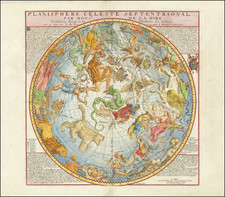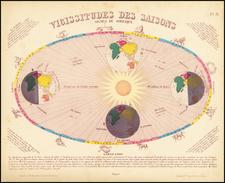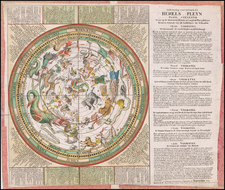Phaenomena in Planetis Primariis by Johann Gabriele Doppelmayr and published in Nuremberg by the Homann Heirs in 1742, is a finely engraved celestial chart detailing the rotations and phases of the primary planets in our solar system. With a focus on the planets both proximal and distant to the Earth, this piece encapsulates the prevailing astronomical understanding and observations of the early 18th century, referencing key figures in the scientific community and their groundbreaking discoveries.
The 1740s witnessed an era of accelerating advancements in observational astronomy. With the invention of the telescope in the early 17th century, scientists like Galileo and Cassini were able to delve deeper into the cosmos, leading to revolutionary insights about our planetary neighbors. This chart, in its detailed renderings and annotations, presents a synthesis of these insights, demonstrating the significance of the planetary rotations, their distinct phases, and the unique features and phenomena associated with each.
Doppelmayr's decision to present the inner planets — Mercury, Venus, and Earth — in the chart's top section provides an immediate visual context for the viewer. The adjacent presentation of Mars, Jupiter, and Saturn elucidates the relative positions of these celestial bodies in the solar system. Such an arrangement is not merely decorative; it reinforces the heliocentric model and encapsulates the evolving understanding of our cosmic neighborhood.
Moreover, this celestial chart does more than just depict planets. It serves as a record paying homage to the observational legacies of scholars like Christoph Scheiner, Galileo Galilei, Christiaan Huygens, Giovanni Domenico Cassini, Robert Hooke, Jacques-Philippe Maraldi, and Francesco Bianchini. The annotations related to Saturn's ring and the unique markings on the planets are a testament to the collaborative spirit of 18th-century astronomers, a compendium of shared knowledge that propelled humanity's understanding of the cosmos.
In its entirety, Phaenomena in Planetis Primariis stands as a testament to the progress of early modern astronomy, reflecting the collective endeavors of scholars and the insatiable curiosity of an era bent on decoding the mysteries of the universe.
Homann Heirs was a German publishing firm that enjoyed a major place in the European map market throughout the eighteenth century. Founded in 1702 by Johann Baptist Homann, the business passed to his son, Christoph, upon Johann’s death in 1724. Christoph died in 1730, aged only 27, and the firm was inherited by subsequent Homann heirs. This altered the name of the company, which was known as Homann Erben, or Homann heirs. The firm continued in business until 1848.









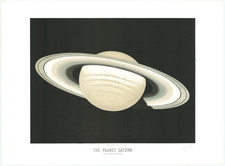
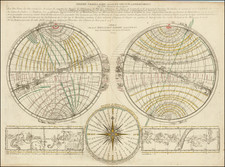
![[Aquila]](https://storage.googleapis.com/raremaps/img/small/68843.jpg)
